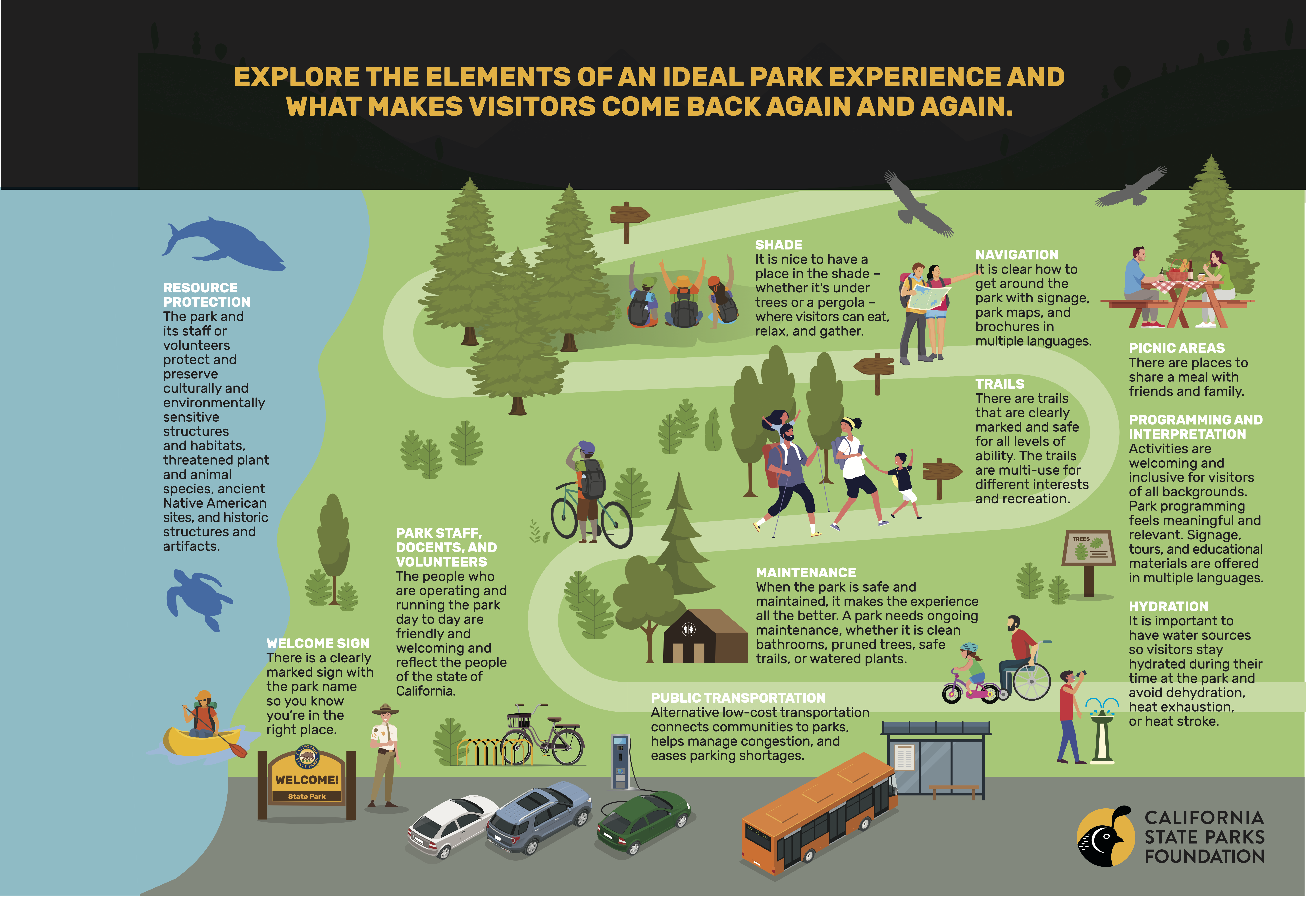Picture this: You wake up on a sunny Saturday morning with no plans. Inspired, you decide to spend the day in a state park you’ve never visited before. You head to your local library to pick up a free California State Library Parks Pass then hop on the bus which drops you off a short distance from the park’s entrance.
As you approach, you are greeted by a big welcome sign with the park’s name, and a friendly park staff member at the entrance kiosk offers you a map and answers questions in your preferred language. They recommend a short interpretive walking loop for your first visit. After filling your water bottle and visiting the restroom, you set out. Along the well-marked trail, vibrant interpretive panels explain the park’s unique plants, animals, history, and cultural relevance of the park. You pause at a shaded bench to marvel at the thriving native ecosystem, reflecting on the generations of people who have shared the same sense of wonder.
This is how easy almost every visit to a state park should be. While remote wilderness areas offer a special experience, many parks can be designed for everyday access — places where Californians can connect with nature, learn about history, and create lifelong memories.
This ideal experience shows how easy and enriching every visit to a state park should be. Yet for too many Californians, barriers — both visible and invisible — stand in the way of enjoying these opportunities.
Understanding the barriers
While California’s state parks belong to everyone, not all Californians have felt welcome or able to access them. Some, but not all, common barriers include:
- Financial barriers: Admission fees and the costs of transportation can make visits unattainable for some families.
- Language barriers: Signage, maps, and programs that don’t reflect California’s multilingual communities can alienate potential visitors.
- Physical accessibility: Parks without ADA-compliant infrastructure can exclude individuals with disabilities.
- Cultural disconnection: A lack of inclusive programming and outreach can make some visitors feel that parks aren’t meant for them.
These barriers can prevent entire communities from experiencing the well-documented mental, physical, and social benefits of time spent in nature.
Reducing barriers, building belonging
The California Natural Resources Agency’s Outdoors for All Strategy provides a comprehensive roadmap to address these challenges and reimagine parks as spaces for everyone.
A priority of this strategy is Fostering Belonging in the Outdoors, which emphasizes the importance of creating parks that not only welcome visitors but actively reflect the diversity and richness of California’s communities. The strategies outlined in this section will help achieve a future where everyone feels safe, welcome, and encouraged in the outdoors, and can enjoy California’s lands and waters without hesitation. This approach addresses systemic inequities by reimagining parks as spaces where everyone feels a deep sense of connection and inclusion.
Key components of a welcoming park experience
Creating parks that feel inviting and inclusive involves thoughtful design and intentional action. Some of the key elements include:
- Public transportation: Alternative low-cost transportation connects communities to parks, helps manage congestion, and eases parking shortages.
- Welcome sign: There is a clearly marked sign with the park name so you know you’re in the right place.
- Navigation: It is clear how to get around the park with signage, park maps, and brochures in multiple languages.
- Park staff, docents, and volunteers: The people who are operating and running the park day to day are friendly and welcoming and reflect the diversity of the state of California.
- Maintenance: When the park is safe and maintained, it makes the experience all the better. A park needs ongoing maintenance, whether it is clean bathrooms, pruned trees, safe trails, or watered plants.
- Picnic areas: There are places to share a meal with friends and family.
- Programming and interpretation: Activities are welcoming and inclusive for visitors of all backgrounds. Park programming feels meaningful and relevant. Signage, tours, and educational materials are offered in multiple languages.
- Hydration: It is important to have water sources so visitors stay hydrated during their time at the park and avoid dehydration, heat exhaustion, or heat stroke.
- Trails: There are trails that are clearly marked and safe for all levels of ability. The trails are multi-use for different interests and recreation.
- Shade: It is nice to have a place in the shade — whether it's under trees or a pergola — where visitors can eat, relax, and gather.
- Resource protection: The park and its staff or volunteers protect and preserve culturally and environmentally sensitive structures and habitats, threatened plant and animal species, ancient Indigenous cultural sites, and historic structures and artifacts.
The bigger picture
Making parks more inclusive isn’t just about access — it’s about creating spaces where people feel they truly belong. Welcoming parks inspire deeper connections to nature, foster community, and build the next generation of environmental stewards.
Whether it’s a family picnic under a shaded grove, a child’s first sighting of a monarch butterfly, or a hiker’s quiet reflection on a historic trail, these moments are universal — and they should be available to everyone.
At California State Parks Foundation, our Access and Experiences program works to improve how people get to parks and enjoy them even more once they visit. We extend grants to parks across the state to help them reimagine their interpretive programming, create connections to parks that foster a sense of belonging, and provide essential resources to park visitors. Recent equity grants, like those supporting inclusive programs and infrastructure improvements, are making a significant impact statewide. All of this work helps bring our image of a perfect park day closer to reality.


